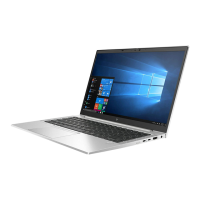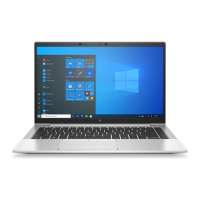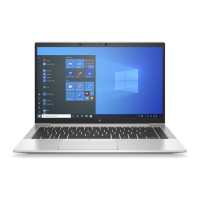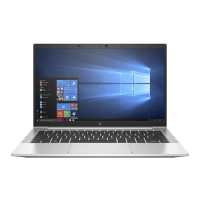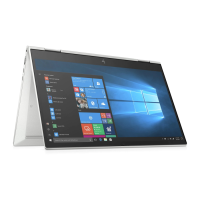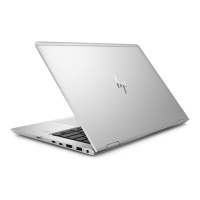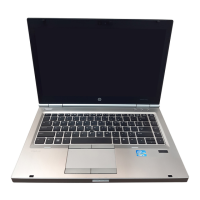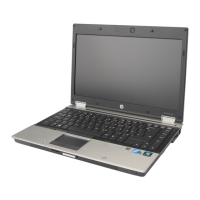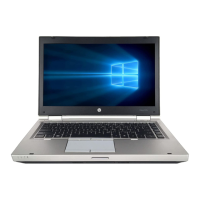Do you have a question about the HP EliteBook 845 G8 and is the answer not in the manual?
Identifies and describes components on the right side of the computer.
Identifies and describes components on the left side of the computer.
Identifies and describes components located on the display assembly.
Details keyboard components, including touchpad and special keys.
Identifies and describes components on the bottom of the computer.
Explains the location and purpose of various labels on the computer.
Provides instructions for inserting and removing a nano SIM card.
Lists major computer components and their corresponding spare part numbers.
Details subcomponents of the display assembly and their part numbers.
Lists the contents and part numbers for the Cable Kit.
Details the components included in the Bracket Kit.
Lists the components included in the Plastics Kit.
Lists miscellaneous parts and their part numbers.
Lists the necessary tools for component removal and replacement.
Provides important considerations for disassembly and assembly procedures.
Explains electrostatic discharge (ESD) and precautions to prevent damage.
Outlines general procedures for removing and replacing computer components.
Steps to prepare the computer before starting disassembly.
Instructions for removing and replacing the bottom cover.
Steps for removing and installing memory modules.
Procedures for removing and installing the WLAN module.
Steps for removing and installing the WWAN module.
Instructions for removing and installing the M.2 solid-state drive.
General procedures for component removal and replacement by authorized personnel.
Steps to prepare the computer for disassembly by a service provider.
Instructions for removing and replacing the computer battery.
Procedures for removing and replacing the Real-Time Clock (RTC) battery.
Steps for removing and installing the computer speakers.
Instructions for removing and installing the card reader board.
Procedures for removing and replacing the power connector cable.
Steps for removing and installing the USB board.
Instructions for removing and installing the fingerprint reader board.
Procedures for removing and installing the touchpad.
Steps for removing and installing the NFC module.
Instructions for removing and installing the computer fan assembly.
Procedures for removing and installing the heat sink.
Steps for removing and installing the system board.
Instructions for removing and disassembling the display assembly.
Procedures for removing and replacing the keyboard with top cover.
Guide to navigating and using the Computer Setup utility.
Instructions for determining BIOS version and performing updates.
How to dynamically select a boot device during startup.
Information on configuring Trusted Platform Module (TPM) settings.
Overview of HP Sure Start technology for BIOS protection.
Methods for creating backups and recovery media using Windows or HP tools.
Various methods to restore the computer system to a previous state.
How to use HP Sure Recover for OS restoration without installed software.
Guide to running hardware diagnostics within the Windows environment.
Instructions for downloading diagnostic tools using product identifiers.
Steps for installing the HP PC Hardware Diagnostics Windows tool.
How to run hardware diagnostics using the UEFI firmware interface.
Procedure to start the HP PC Hardware Diagnostics UEFI tool.
Guide to creating a bootable USB drive for UEFI diagnostics.
Steps to download the most recent UEFI diagnostic tool version.
Customizing settings for remote hardware diagnostics via UEFI.
Details on computer dimensions, weight, input power, and temperature ratings.
Technical specifications for the 35.6 cm (14.0 in) display.
Technical specifications for various solid-state drive capacities.
Instructions for restoring nonvolatile memory to factory defaults.
Details troubleshooting steps for nonvolatile memory.
Addresses common questions regarding nonvolatile memory and BIOS.
Information on HP Sure Start for BIOS protection and recovery.
General power cord requirements applicable worldwide.
Specific power cord requirements based on country or region.
Identifies and describes components on the right side of the computer.
Identifies and describes components on the left side of the computer.
Identifies and describes components located on the display assembly.
Details keyboard components, including touchpad and special keys.
Identifies and describes components on the bottom of the computer.
Explains the location and purpose of various labels on the computer.
Provides instructions for inserting and removing a nano SIM card.
Lists major computer components and their corresponding spare part numbers.
Details subcomponents of the display assembly and their part numbers.
Lists the contents and part numbers for the Cable Kit.
Details the components included in the Bracket Kit.
Lists the components included in the Plastics Kit.
Lists miscellaneous parts and their part numbers.
Lists the necessary tools for component removal and replacement.
Provides important considerations for disassembly and assembly procedures.
Explains electrostatic discharge (ESD) and precautions to prevent damage.
Outlines general procedures for removing and replacing computer components.
Steps to prepare the computer before starting disassembly.
Instructions for removing and replacing the bottom cover.
Steps for removing and installing memory modules.
Procedures for removing and installing the WLAN module.
Steps for removing and installing the WWAN module.
Instructions for removing and installing the M.2 solid-state drive.
General procedures for component removal and replacement by authorized personnel.
Steps to prepare the computer for disassembly by a service provider.
Instructions for removing and replacing the computer battery.
Procedures for removing and replacing the Real-Time Clock (RTC) battery.
Steps for removing and installing the computer speakers.
Instructions for removing and installing the card reader board.
Procedures for removing and replacing the power connector cable.
Steps for removing and installing the USB board.
Instructions for removing and installing the fingerprint reader board.
Procedures for removing and installing the touchpad.
Steps for removing and installing the NFC module.
Instructions for removing and installing the computer fan assembly.
Procedures for removing and installing the heat sink.
Steps for removing and installing the system board.
Instructions for removing and disassembling the display assembly.
Procedures for removing and replacing the keyboard with top cover.
Guide to navigating and using the Computer Setup utility.
Instructions for determining BIOS version and performing updates.
How to dynamically select a boot device during startup.
Information on configuring Trusted Platform Module (TPM) settings.
Overview of HP Sure Start technology for BIOS protection.
Methods for creating backups and recovery media using Windows or HP tools.
Various methods to restore the computer system to a previous state.
How to use HP Sure Recover for OS restoration without installed software.
Guide to running hardware diagnostics within the Windows environment.
Instructions for downloading diagnostic tools using product identifiers.
Steps for installing the HP PC Hardware Diagnostics Windows tool.
How to run hardware diagnostics using the UEFI firmware interface.
Procedure to start the HP PC Hardware Diagnostics UEFI tool.
Guide to creating a bootable USB drive for UEFI diagnostics.
Steps to download the most recent UEFI diagnostic tool version.
Customizing settings for remote hardware diagnostics via UEFI.
Details on computer dimensions, weight, input power, and temperature ratings.
Technical specifications for the 35.6 cm (14.0 in) display.
Technical specifications for various solid-state drive capacities.
Instructions for restoring nonvolatile memory to factory defaults.
Details troubleshooting steps for nonvolatile memory.
Addresses common questions regarding nonvolatile memory and BIOS.
Information on HP Sure Start for BIOS protection and recovery.
General power cord requirements applicable worldwide.
Specific power cord requirements based on country or region.
| RAM | Up to 64 GB DDR4-3200 SDRAM |
|---|---|
| Storage | Up to 2 TB PCIe NVMe SSD |
| Processor | AMD Ryzen 5000 series |
| Display | 14-inch, FHD (1920 x 1080), IPS |
| Graphics | AMD Radeon Graphics |
| Operating System | Windows 10 Pro |
| Battery | 3-cell, 53 Wh Li-ion |
| Wireless | Realtek 802.11a/b/g/n/ac (2x2) Wi-Fi and Bluetooth 5 combo |
| Audio | Dual stereo speakers, dual array microphones |
| Ports | 1 x HDMI 2.0, 1 x headphone/microphone combo |
